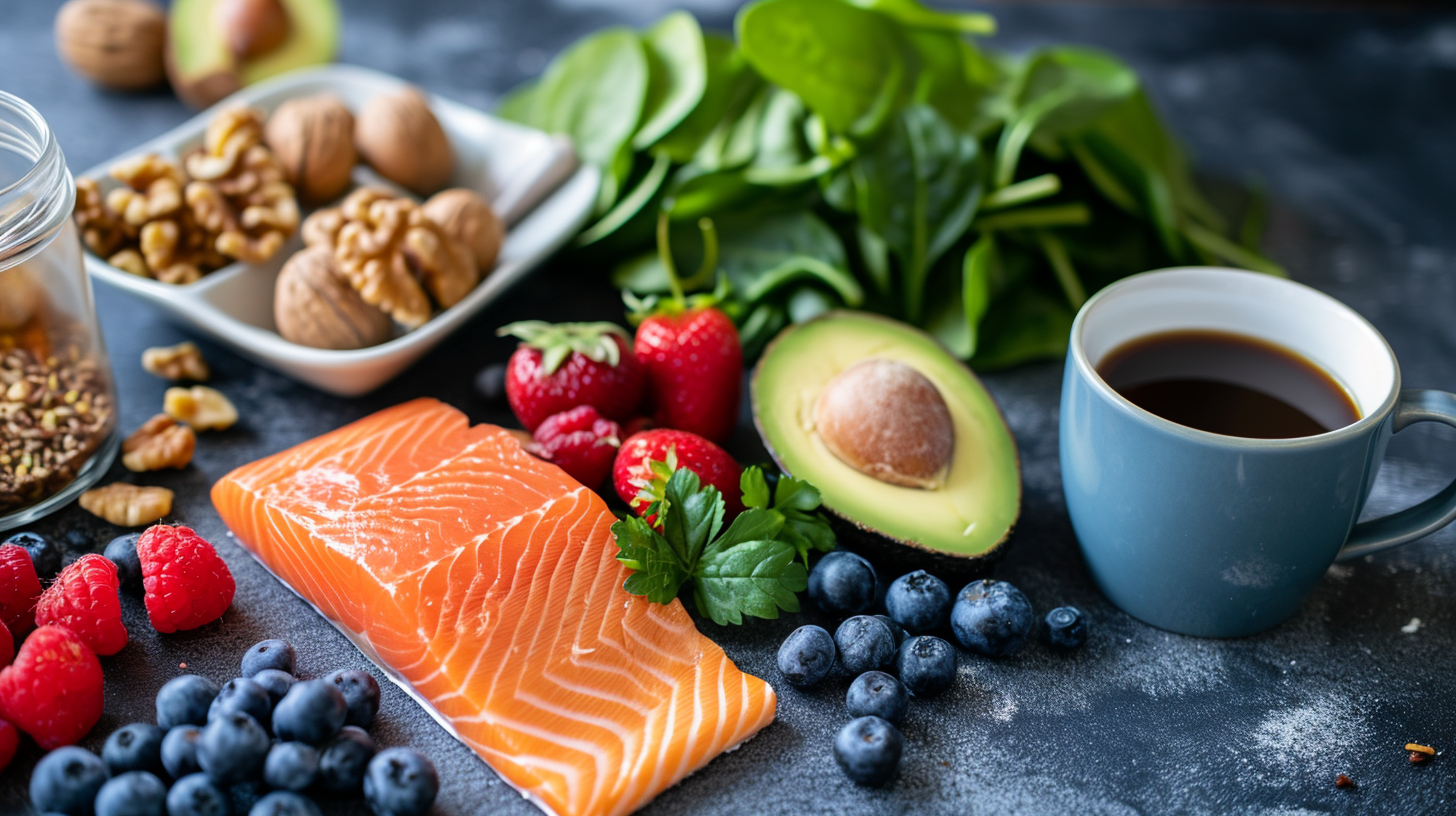Satisfy Hunger With Smart Food Choices!

Satisfy Hunger With Smart Food Choices!
Did you know that the key to satisfying your hunger lies in making smart food choices? It’s true! In fact, research shows that selecting high satiety foods can prevent those annoying hunger pangs shortly after eating. You see, many processed foods may taste delicious, but they often lack the nutritional punch needed to keep you feeling satisfied and nourished. This can lead to overeating and unwanted weight gain.
The secret lies in understanding your body’s nutritional needs and finding the right balance of macronutrients. Protein and fat are particularly effective in inducing satiety, so it’s crucial to make sure you’re getting enough of these nutrients each day. But don’t worry, incorporating fiber-rich foods into your diet and choosing healthy snack options can also help keep hunger at bay.
Remember, portion control and mindful eating are essential for maintaining a healthy relationship with food. By staying satiated, not only will you have better focus throughout the day but also improve your overall well-being. So let’s dive in and discover how to satisfy your hunger with smart food choices!
Key Takeaways
Selecting high satiety foods is important for preventing excessive hunger and overeating.
Processed foods are often less satiating and can lead to weight gain due to their poor nutrient profiles.
Protein and fat are the macronutrients most effective in inducing satiety, so it is important to meet daily needs for these nutrients.
Being satiated after meals indicates that nutritional needs have been met and supports overall health and function.
Understanding Nutritional Needs
If you want to stop feeling hungry all the time, it’s important to understand that making smart food choices is key to meeting your nutritional needs. Nutrient density should be a top priority when selecting foods for your meals. This means choosing foods that are rich in essential nutrients and low in empty calories. When you focus on nutrient-dense options, you ensure that your body receives the vitamins, minerals, and other compounds it needs to function optimally.
Mindful meal planning is another crucial aspect of satisfying hunger and meeting nutritional needs. By taking the time to plan out balanced meals, you can ensure that you’re getting a variety of nutrients from different food groups. Include plenty of fruits, vegetables, whole grains, lean proteins, and healthy fats in your meals to provide a diverse array of nutrients.
Satiety plays a significant role in weight loss as well. When you choose foods that are high in satiety (such as protein and healthy fats), they help keep you feeling full for longer periods of time. This can prevent overeating and snacking on unhealthy foods throughout the day.
To achieve satiety and promote weight loss, it’s important to balance macronutrients in your meals. Protein and fat are particularly effective at inducing feelings of fullness, so make sure each meal includes these components. Incorporate lean sources of protein like chicken breast or tofu, along with healthy fats from avocados or nuts.
By understanding your nutritional needs, practicing mindful meal planning, prioritizing satiety through macronutrient balance, and making smart food choices overall, you can satisfy hunger while also promoting weight loss. Now let’s dive deeper into how balancing macronutrients contributes to long-lasting satiety
Balancing Macronutrients
Balancing macronutrients is crucial for maintaining satiety and preventing excessive cravings. Did you know that a well-balanced meal with adequate amounts of protein and healthy fats can significantly reduce overall calorie intake by up to 20%? Protein and fat are the most effective in inducing feelings of fullness throughout the day.
To understand why protein and fat are important, let’s take a look at the role of hormones in appetite and satiety. Leptin, known as the “satiety hormone,” signals your brain when you’ve had enough to eat, while ghrelin, known as the “hunger hormone,” stimulates your appetite. Consuming a diet high in protein and healthy fats helps regulate these hormones, keeping you feeling satisfied for longer periods.
So how can you ensure you’re getting enough protein and fat? Here’s a handy table to guide you:
Protein Sources | Healthy Fat Sources |
|---|---|
Chicken Breast | Avocado |
Greek Yogurt | Olive Oil |
Salmon | Nuts |
Tofu | Chia Seeds |
Lentils | Coconut Oil |
Incorporating these foods into your meals will not only provide essential nutrients but also help keep hunger at bay throughout the day. Remember, a hungry mind is less likely to focus on important tasks.
Now that you understand the importance of balancing macronutrients with protein and healthy fats, let’s explore another strategy for staying satiated throughout the day - incorporating fiber-rich foods into your diet.
Incorporating Fiber-Rich Foods
To keep your appetite in check and maintain long-lasting fullness, it’s time to explore the power of fiber-rich foods in your meals. Fiber plays a crucial role in promoting satiety, as it adds bulk to your meals and slows down digestion, keeping you feeling satisfied for longer periods of time.
One way to increase your fiber intake for better appetite control is by incorporating more fruits and vegetables into your diet. These natural sources of fiber are not only low in calories but also packed with essential vitamins and minerals. Aim to include a variety of colorful produce in your meals to ensure you’re getting a wide range of nutrients while keeping hunger at bay.
Whole grains are another excellent source of fiber that can help promote satiety. Opt for whole wheat bread, brown rice, quinoa, and oats instead of their refined counterparts. These complex carbohydrates take longer to digest, providing a steady release of energy and helping you feel fuller for longer.
Legumes such as beans, lentils, and chickpeas are also high in fiber and protein, making them an excellent choice for promoting satiety. They can be added to salads, soups, or even used as a base for vegetarian dishes.
Including fiber-rich foods in your diet has numerous benefits beyond just appetite control. It can help regulate blood sugar levels, improve digestion and gut health, lower cholesterol levels, and support weight management.
Now that you understand the role of fiber in promoting satiety and how to increase your intake through various food sources, let’s move on to choosing healthy snack options that will keep you satisfied throughout the day without sabotaging your goals.
Choosing Healthy Snack Options
When it comes to selecting snacks that will keep you feeling full and satisfied, opt for nutrient-dense options like Greek yogurt with berries or a handful of nuts and seeds. These nutrient-dense snacks are packed with essential vitamins, minerals, and macronutrients that will not only satisfy your hunger but also provide your body with the necessary fuel to function at its best.
Protein-rich options are especially effective in promoting satiety. Protein takes longer to digest than carbohydrates, which means it keeps you feeling fuller for a longer period of time. Some great protein-rich snack options include hard-boiled eggs, cottage cheese, or even a small portion of lean meat or fish.
Incorporating healthy fats into your snacks is another smart choice for enhancing satiety. Healthy fats are digested slowly by the body, helping to prolong feelings of fullness. Avocado slices with whole-grain crackers or a tablespoon of almond butter on apple slices are excellent choices for satisfying your hunger while providing essential nutrients.
By choosing these nutrient-dense snacks that are rich in protein and healthy fats, you’ll not only satisfy your hunger but also provide your body with the necessary nutrients it needs throughout the day. This will set the stage for better portion control and mindful eating habits in the subsequent section.
Portion Control and Mindful Eating
Indulge in the art of savoring each bite mindfully, allowing your senses to dance with delight as you master the delicate dance of portion control. When it comes to satisfying hunger and maintaining a healthy weight, mindful portion sizes are key. By being aware of how much food you’re consuming, you can ensure that you’re giving your body exactly what it needs without overindulging.
Mindful eating habits go hand in hand with portion control. It’s about paying attention to your body’s hunger and fullness cues, and eating slowly and intentionally. Take the time to truly enjoy each mouthful, savoring the flavors and textures. This allows your brain to register when you’ve had enough, preventing overeating.
Another important aspect of mindful eating is meal planning. By taking the time to plan out your meals in advance, you can make sure that they are balanced and nourishing. Include plenty of high satiety foods like lean proteins, healthy fats, and fiber-rich fruits and vegetables. These nutrient-dense choices will keep you feeling satisfied for longer periods of time.
In addition to portion control and mindful eating habits, it’s also crucial to listen to your body’s signals of hunger and fullness. Learn to distinguish between emotional cravings and true physical hunger. Sometimes we eat out of boredom or stress rather than genuine hunger. By tuning into your body’s needs, you can make smarter food choices that truly satisfy.
Mastering the art of portion control and mindful eating takes practice but is well worth the effort. Not only will it help satisfy your hunger more effectively, but it will also contribute to a healthier relationship with food overall. So take pleasure in each bite while keeping an eye on portion sizes – your body will thank you for it!
Frequently Asked Questions
How do I determine my individual nutritional needs?
To determine your individual nutritional needs, consider consulting with one of our Lifestyle Wellness Coaches or a nutritionist who can create personalized nutrition plans based on factors like age, gender, weight, and activity level. Tracking your food intake can also help identify any deficiencies or excesses in your diet.
What are some examples of high protein and high-fat foods?
To meet your nutritional needs and feel satisfied, opt for protein-rich and fat-packed foods. High protein options include lean meats, fish, eggs, and Greek yogurt. For high-fat choices, try avocados, nuts, seeds, and olive oil. These will help keep you full and focused throughout the day.
How can I incorporate more fiber into my diet?
To increase fiber intake, you can enjoy the benefits of fiber by incorporating easy ways to add it to your diet. Include whole grains, fruits, vegetables, and legumes in your meals for a healthier digestive system and improved overall health.
What are some healthy snack options that are both satisfying and nutritious?
Looking for healthy snack options that are both satisfying and nutritious? Try these delicious recipes: Greek yogurt with berries, roasted chickpeas, apple slices with almond butter, and homemade trail mix. Snacking can provide benefits for weight loss by keeping you satisfied and preventing overeating.
What strategies can I use to practice portion control and mindful eating?
To practice portion control and develop mindful eating habits, start by using smaller plates and bowls, measuring your portions, and avoiding distractions while eating. Practice self-control by listening to your body’s hunger and fullness cues.
Conclusion
So remember, when it comes to satisfying your hunger, making smart food choices is key. By understanding your nutritional needs and balancing your macronutrients with protein and fat, you can ensure that you stay satiated throughout the day. Incorporating fiber-rich foods into your diet can also help keep you feeling full for longer periods of time. And when it comes to snacking, opt for healthy options that are both tasty and filling. Lastly, practicing portion control and mindful eating will help you maintain a healthy weight and overall well-being. So choose wisely and nourish yourself with foods that truly satisfy!



